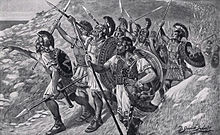¡Thalatta! ¡Thalatta!

¡Thálatta! ¡Thálatta! (en griego: Θάλαττα! θάλαττα! «¡El mar! ¡El mar!») fue el grito de alegría que pronunciaron los diez mil griegos que vieron el Mar Negro desde el Monte Teques (Θήχης) cerca de Trapezunte, después de participar en la fallida marcha de Ciro el Joven contra el Imperio Persa en el año 401 a. C. La montaña estaba a sólo cinco días de marcha de la ciudad costera aliada de Trapezunte. La historia la cuenta Jenofonte en su Anábasis.[1] Se cree el incidente ocurrió en los primeros meses del 400 a. C.[2]
El relato de Jenofonte[editar]
Jenofonte describe la escena de la siguiente manera:
From there they went through four days’ march and twenty parasangs to a large, prosperous and populous city which was called Gymnias. From this country the ruler sent a guide for the Greeks, so that he could lead them through the country which was an enemy of theirs. When that man came he said that he would lead them in five days to a place from which they would see sea; if not, he declared that he was a dead man. And as he led them, when he brought them into the enemy territory, he began encouraging them to burn and lay waste the country. From which it became clear that it was for this reason he had come, not because of his goodwill towards the Greeks. And they arrive on top of the mountain on the fifth day. The mountain was called Theches. And when the first men arrived on top of the mountain and saw the sea below them, there was a lot of shouting. When Xenophon and the rearguard heard this, they thought that some other enemies were attacking them from in front. For from behind also the people from the land which was burning were following them, and the rearguard had killed some of them and taken some of them prisoner after making an ambush, and they had captured about 20 wickerwork shields covered with raw hide from oxen with the hair still on them.
But when the shouting was getting louder and nearer, and those who were continually arriving kept running fast towards those who were continually shouting, it seemed to Xenophon to be something more serious, and mounting on a horse and taking with him Lycius and the cavalrymen he began going to help. And very soon they hear the soldiers shouting ‘Sea! Sea!’ and passing the word along. Suddenly all of them together began running, including the rearguards, and the pack animals and horses were made to gallop. And when they arrived on the summit, then they began embracing one another and the generals and the captains, weeping. And suddenly, when someone passed the word along, the soldiers bring some stones and make a large cairn. Then they placed a quantity of rawhide skins on it as an offering, and staffs, and the captured shields, and the guide began cutting up the shields himself and encouraging the others to do so. After that the Greeks send the guide away after giving him gifts from the common property – a horse and a silver libation-bowl and a Persian outfit and ten darics; he kept asking particularly for their finger-rings and he took a lot of them from the soldiers. And after pointing out a village to them where they would encamp and the road which they would take into the territory of the Macrones, when evening came, he departed, going away during the night.[3]
Ubicación[editar]
En los últimos años se han realizado varios intentos para descubrir la ubicación exacta del monte Teques, desde donde Jenofonte y el ejército de diez mil hombres vieron el mar. Una ubicación viable, que Brennan y Tuplin llaman «el principal candidato actual», es una colina situada aproximadamente a medio camino entre Pirahmet y Maçka, cerca de una antigua carretera. Aquí, en 1996, Tim Mitford, que había sido guiado a la montaña por un lugareño, Celal Yılmaz, observó un gran montón de piedras circular, de 12 metros de diámetro, que bien podría ser la plataforma que Jenofonte describe como montada por los soldados para montar un trofeo. [4]
La identificación de Mitford fue apoyada por V. Manfredi, quien, volviendo a visitar el sitio con Mitford unos años más tarde, sugirió que el mojón de Jenofonte no era el de 12 metros, sino una segunda estructura cercana, redonda con forma de rosquilla, de 24 metros de ancho. [5]
Sin embargo, Brennan y Tuplin sostienen que esta es solo una de varias soluciones posibles, dependiendo de la ruta que siguieran Jenofonte y el ejército, y creen que es posible que el asunto nunca se resuelva por completo. [6]
El nombre Teques no se encuentra en ninguna otra fuente antigua. La colina que Mitford cree que es la de Jenofonte se llama hoy Deveboynu Tepe ('Colina de Cuello de Camello').
Lingüística[editar]
Thála tt a (θάλαττα, pronunciado [ tʰálatta ]</link> ) era la forma ática (es decir, ateniense) de la palabra, tal como aparece en el texto de Jenofonte. En la mayoría de los demás dialectos del griego antiguo, así como en el griego moderno, es thála ss a (θάλασσα).
Referencias[editar]
- ↑ Jenofonte. Anábasis. 4.7.24. Consultado el 17 de septiembre de 2013.
- ↑ Brennan & Tuplin (2023), p. 138.
- ↑ Jenofonte, Anábasis, 4.7.19–27.
- ↑ Mitford, T. (2000). "Thalatta, Thalatta: Xenophon's View of the Black Sea". Anatolian Studies, Vol. 50 (2000), pp. 127–131; includes a map, which shows that the mountain is approximately 21 km south of Maçka.
- ↑ Manfredi, V (2004). «The identification of Mount Theches in the itinerary of the Ten Thousand: a new hypothesis». En Christopher Tuplin; Vincent Azoulay, eds. Xenophon and His World: Papers from a Conference Held in Liverpool in July 1999 (No. 172,. Stuttgart: Steiner. p. 319.
- ↑ Brennan, S. G., & Tuplin, C. J. (2023). "Theches: an elusive mountain". Anatolian Studies, 1–21.
